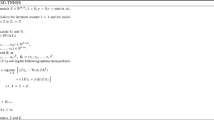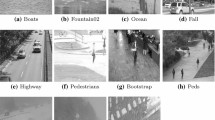Abstract
Many topics in pattern recognition and machine learning, such as subspace learning, image restoration, background modeling, can be viewed as the matrix decomposing problem. Double nuclear norm-based matrix decomposition (DNMD) is a new emerging method for dealing with the image data corrupted by continuous occlusion. The method uses a unified low rank assumption to characterize the real image data and continuous occlusion. However, one major limitation of the nuclear norm is that each singular value is treated equally, since the nuclear norm is defined as the sum of all singular values. Thus the rank function may not be well approximated in practice. To overcome this drawback, this paper presents double truncated nuclear norm-based matrix decomposition (DTNMD). The truncated nuclear norm can reflect the rank function more accurate and robust. Experimental results show encouraging results of the proposed algorithm in comparison to the state-of-the-art matrix completion methods on both synthetic and real visual datasets.




Similar content being viewed by others
References
Akilan T, Wu QMJ (2018) Double encoding-slow decoding image to image CNN for foreground identification with application towards intelligent transportation. In: IEEE confs on internet of things, green computing, pp 395–403
Akilan T, Wu QMJ, Wei J, Amin S, Jie H (2018a) New trend in video foreground detection using deep learning. In: 61th IEEE International midwest symposium on circuits and systems, pp 889–892
Akilan T, Wu QMJ, Yang Y (2018b) Fusion-based foreground enhancement for background subtraction using multivariate multi-model Gaussian distribution. Inf Sci 430–431:414–431
Babaee M, Dinh DT, Rigoll G (2018) A deep convolutional neural network for background subtraction. Pattern Recogn 76:635–649
Bouwmans T, Sobral A, Javed S, Jung S, Zahzah E (2017) Decomposition into low-rank plus additive matrices for background/foreground separation: a review for a comparative evaluation with a large-scale dataset. Comput Sci Rev 23:1–71
Boyd S, Parikh N, Chu E, Peleato B, Eckstein J (2010) Distributed optimization and statistical learning via the alternating direction method of multipliers. Found Trends Mach Learn 3(1):1–122
Candès E, Li X, Ma Y, Wright J (2011) Robust principal component analysis? J ACM 58(3):1–37
Goldstein T, O’Donoghue B, Setzer S, Baraniuk R (2014) Fast alternating direction optimization methods. SIAM J Imaging Sci 7(3):1588–1623
He R, Sun Z, Tan T, Zheng W (2011) Recovery of corrupted low-rank matrices via half-quadratic based nonconvex minimization. In: International conference on computer vision and pattern recognition, pp 2889–2896
Hu Y, Zhang D, Ye J, Li X, He X (2013) Fast and accurate matrix completion via truncated nuclear norm regularization. IEEE Trans Pattern Anal Mach Intell 35(9):2117–2130
Huo Z, Nie F, Huang H (2016) Robust and effective metric learning using capped trace norm. In: ACM SIGKDD international conference on knowledge discovery & data mining, pp 1605–1614
Li J, Kong Y, Zhao H, Yang J, Fu Y (2016) Learning fast low-rank projection for image classification. IEEE Trans Image Process 25(10):4803–4814
Liu G, Yang J (2019) Exploiting color volume and color difference for salient region detection. IEEE Trans Image Process 28(1):6–16
Liu G, Lin Z, Yan S, Sun J, Yu Y, Ma Y (2013) Robust recovery of subspace structures by low-rank representation. IEEE Trans Pattern Anal Mach Intell 35(1):171–184
Liu Q, Lai Z, Zhou Z, Kuang F (2016) A truncated nuclear norm regularization method based on weighted residual error for matrix completion. IEEE Trans Image Process 25(1):316–330
Nanda A, Sa P, Chauhan D, Majhi B (2017) A person re-identification framework by inlier-set group modeling for video surveillance. J Ambient Intell Humaniz Comput. https://doi.org/10.1007/s12652-017-0580-7
Nie F, Wang H, Huang H, Ding C (2015) Joint Schatten p-norm and lp-norm robust matrix completion for missing value recovery. Knowl Inf Syst 42(3):525–544
Oh TH, Matsushita Y, Tai YW, Kweon IS (2018) Fast randomized singular value thresholding for low-rank optimization. IEEE Trans Pattern Anal Mach Intell 40(2):376–391
Ramalingam S, Rama C (2018) Dimensionality reduced local directional number pattern for face recognition. J Ambient Intell Humaniz Comput 9(1):95–103
Sun Q, Xiang S, Ye J (2013) Robust principal component analysis via capped norms. In: ACM SIGKDD international conference on knowledge discovery & data mining, pp 311–319
Varga D, Szirányi T (2017) Robust real-time pedestrian detection in surveillance videos. J Ambient Intell Humaniz Comput 8(1):79–85
Xu J, Zhang L, Zhang D, Feng X (2017) Multi-channel weighted nuclear norm minimization for real color image denoising. In: International conference on computer vision, pp 1105–1113
Yang J, Luo L, Qian J, Tai Y, Zhang F, Xu Y (2017) Nuclear norm based matrix regression with applications to face recognition with occlusion and illumination changes. IEEE Trans Pattern Anal Mach Intell 39(1):156–171
Zhang T (2010) Analysis of multi-stage convex relaxation for sparse regularization. J Mach Learn Res 11(2):1081–1107
Zhang S, Xin J (2017) Minimization of transformed l1 penalty: closed form representation and iterative thresholding algorithms. Commun Math Sci 15(2):511–537
Zhang F, Yang J, Tai Y, Tang J (2015) Double nuclear norm-based matrix decomposition for occluded image recovery and background modeling. IEEE Trans Image Process 24(6):1956–1966
Zhou Z, Jin Z (2016) Double nuclear norm-based robust principal component analysis for image disocclusion and object detection. Neurocomputing 205:481–489
Acknowledgements
This research is supported in part by the National Key R&D Program under Grant 2017YFC0804002, the National Science Foundation of China under Grant Nos. U1831127, 61603192, 61572257, 61772277 and 61772254, the 2011 Collaborative Innovation Center of Internet of Things Technology and Intelligent Systems under Grant Nos. IIC1705, the Jiangsu Key Laboratory of Image and Video Understanding for Social Safety (Nanjing University of Science and Technology) (Grant No. 30916014107), the China Postdoctoral Science Foundation funded project (Grant No. 2017M611656).
Author information
Authors and Affiliations
Corresponding author
Additional information
Publisher’s Note
Springer Nature remains neutral with regard to jurisdictional claims in published maps and institutional affiliations.
Rights and permissions
About this article
Cite this article
Yang, Z., Zhang, H., Xu, D. et al. Double truncated nuclear norm-based matrix decomposition with application to background modeling. J Ambient Intell Human Comput 14, 14921–14930 (2023). https://doi.org/10.1007/s12652-018-1148-x
Received:
Accepted:
Published:
Issue Date:
DOI: https://doi.org/10.1007/s12652-018-1148-x




